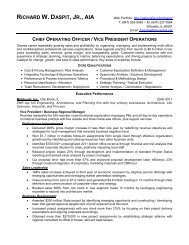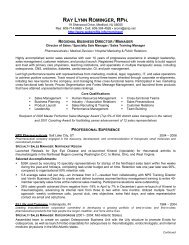The Art of Practical and Precise Strain Based ... - Webprofile.info
The Art of Practical and Precise Strain Based ... - Webprofile.info
The Art of Practical and Precise Strain Based ... - Webprofile.info
- No tags were found...
Create successful ePaper yourself
Turn your PDF publications into a flip-book with our unique Google optimized e-Paper software.
Applications Note 1-4:uncertainty in Chapter 5we learn that it is desirable to maximize the Òdegrees <strong>of</strong>freedomÓ to minimize measurement uncertainty. When an eleven-coefficient fit isapplied to an eleven-point data set, where each computed coefficient effectivelynegates one degree <strong>of</strong> freedom, zero degrees <strong>of</strong> freedom results! To produce superiorresults, the order <strong>of</strong> the curve fit used must be much less than the number <strong>of</strong>data points to which the curve fit is being applied. With reference to equation 1-4,N-K equals the number <strong>of</strong> degrees <strong>of</strong> freedom for the curve fit. Even when plenty<strong>of</strong> data points exist, higher order polynomial coefficients tend to become exceedinglysmall in magnitude <strong>and</strong> calculations utilizing more than three coefficientsbecome cumbersome <strong>and</strong> processor-intensive therefore limiting the rate at whichdata can be processed. In all cases, the computed curve fit should be printed overlyingthe collected data so that the quality <strong>of</strong> the fit as well as the scatter around thecomputed response can be assessed. Another measure <strong>of</strong> the quality <strong>of</strong> a curve fitutilizes the ÒSt<strong>and</strong>ard Estimate <strong>of</strong> ErrorÓ or ÒSEEÓ method computed as follows:SEE =å ( Y i Ð Y-------------------------------- ci( N Ð K) Where: N= Number <strong>of</strong> data pointsK= Number <strong>of</strong> curve fit coefficientsY i = ith measurementY ci = computed value <strong>of</strong> fit at the ith data point(EQ 1-4)<strong>The</strong> most rapid method <strong>of</strong> sensor output linearization involves the use <strong>of</strong> analograther than digital correction <strong>of</strong> the output data. By using amplifiers in the signalpath that possess nonlinear gains that effectively compensate for the nonlinear output<strong>of</strong> the sensor, the effective b<strong>and</strong>width <strong>of</strong> the collected data is limited only bythe b<strong>and</strong>width <strong>of</strong> the linear <strong>and</strong> nonlinear amplifiers employed.With present computational capabilities, computational-corrected nonlinear outputsensors are best suited to lower-frequency applications <strong>of</strong> less than 1 KHz. <strong>The</strong>majority <strong>of</strong> pressure sensor uses fall into this frequency b<strong>and</strong>. <strong>The</strong> implementation<strong>of</strong> nonlinear analog amplifiers, or the computational methods described above,implies prior knowledge <strong>of</strong> the sensor output characteristic. <strong>The</strong> collection <strong>of</strong> thisknowledge, as well as the implementation <strong>of</strong> the required s<strong>of</strong>tware implies thatadditional cost per data channel will be incurred.<strong>The</strong> <strong>Art</strong> <strong>of</strong> <strong>Practical</strong> <strong>and</strong> <strong>Precise</strong> <strong>Strain</strong> <strong>Based</strong> Measurement 2nd Edition © 1999 CHAPTER 1-15
















